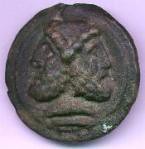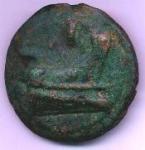
PREV ARTICLE
NEXT ARTICLE
FULL ISSUE
ROMAN COIN FLIPPING: HEADS OR SHIPS
A blog post this week discussed the origin of a coin-tossing term I hadn't encountered before - "heads or ships?". Interesting take on coin tossing in ancient times.
-Editor
I see in a rather odd article about coin-tossing the Telegraph UK mentions the ancient Roman past-time which they erroneously call Head or Ships but which was actually called Capita vel Navia, Heads or Ships because of Janus, the two headed god (yes, the one January is named after, the god of beginnings).
When Saturn arrived by ship, Janus received him here as his guest and learned from him the art of husbandry, thereby improving a mode of life which, before men understood how to make use of the fruits of the earth, had been brutish and rude; and he rewarded Saturn by sharing his kingdom with him. [22] Janus was also the first to strike coins of bronze, and in this too he showed his high regard for Saturn; for on one side of a coin he stamped the image of his own head but on the other side a ship, that posterity might preserve the remembrance of Saturn, whose coming had been by ship. And that the bronze coinage was so marked is evident even today from the game of chance in which boys throw pennies in the air, calling "heads" or "ships" for the game bears witness to the old usage.


Janus was a very frequent image on coins throughout Roman history but the coin referred to by Macrobius was called the "As" or "Aes Grave". It was a bronze coin that featured Janus on one side and a ship's prow on another. These were typically minted around the Punic Wars (early 3rd century BC) and were replaced eventually by the silver denarius. To read the complete article, see: Heads or Ships: Roman Coin Flipping (badlatin.wordpress.com/2009/12/31/heads-or-ships-roman-coin-flipping/)
The Telegraph's article discusses famous coin tosses in history. Here are a couple examples.
-Editor
One of the most significant coin tosses in the United State's history involved the naming of the city of Portland, Oregon in 1845. Asa Lovejoy and Francis Pettygrove, who owned the claim to the land that would later become Portland, each wanted to name their new town after their respective hometowns of Boston, Massachusetts and Portland, Maine. Pettygrove prevailed in the coin flip, and the town was named Portland. In 1903, the Wright brothers flipped a coin to see which one of them would take to the air in the first ever powered flight. Wilbur won the toss but his attempt was only partially successful. Orville's later flight was considered the first example of powered flight.
To read the complete article, see:
Coin tossing through the ages
(www.telegraph.co.uk/science/science-news/6911921/ The Numismatic Bibliomania Society is a non-profit organization promoting numismatic literature. See our web site at coinbooks.org. To submit items for publication in The E-Sylum, write to the Editor at this address: whomren@gmail.com To subscribe go to: https://my.binhost.com/lists/listinfo/esylum All Rights Reserved. NBS Home Page Contact the NBS webmaster 
|